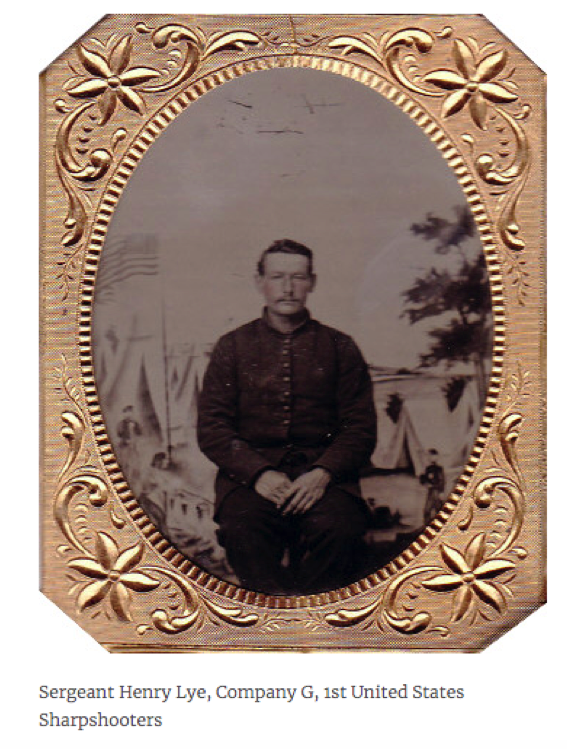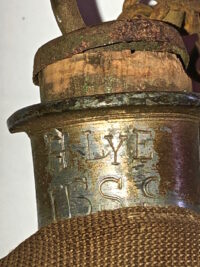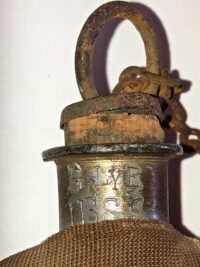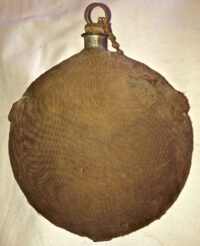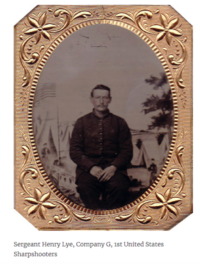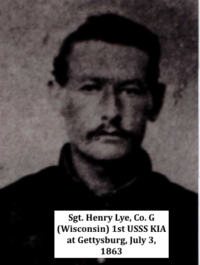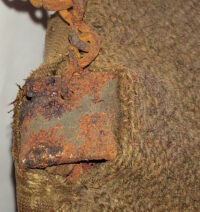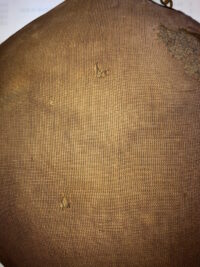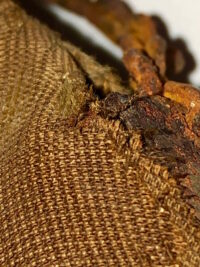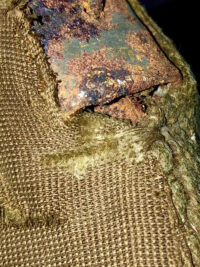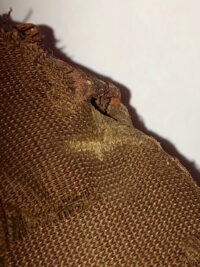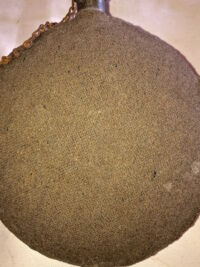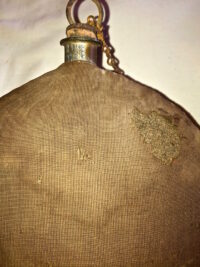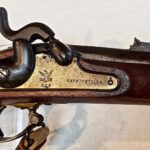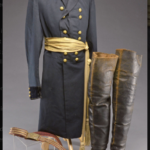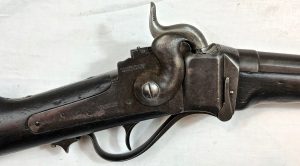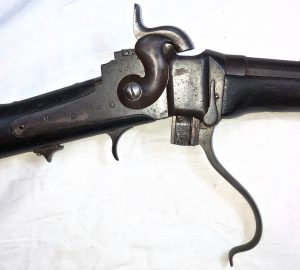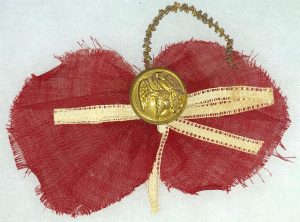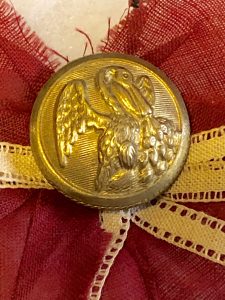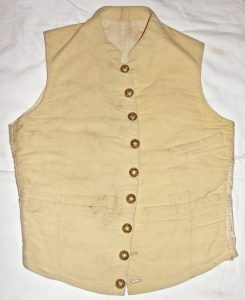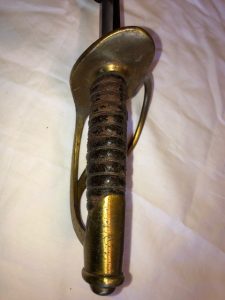Id’d M1859 Smoothside Canteen – Sgt. Henry Lye, 1st US Sharpshooters, Mortally Wounded at Gettysburg
SOLD
Id’d M1859 Smoothside Canteen – Sgt. Henry Lye, 1st US Sharpshooters, Mortally Wounded at Gettysburg – This typical M1859 smoothside canteen, retains its entire gray wool cover, as well as a second, light brown, thin cotton canvas cover, hand sewn to one side of the canteen; enmeshed in a very small area of this canvas cover, are the remnants of what appears to be a green velvet, that was once woven into the canvas element. The presence of the green velvet may be remnants of postwar, decorative elements, applied when the canteen was displayed in a GAR hall; display in a GAR hall is also indicated by the dull, gold colored paint, applied long ago, some time shortly after the war. We have encountered many war period items with this applied, dull gold paint, that were displayed in GAR halls. The original stopper and chain are present, as are all three, sling guides, which exhibit areas of surface rust; the cotton sling is no longer present. Most significantly, somewhat crudely die-stamped into the pewter mouthpiece, is the following:
“H LYE
USS”
This die-stamping of Sgt. Lye’s name preceded the painting, as much of the gold paint remains down in the impressions and furrows created by the die-stamped letters. We have shown the canteen to several respected dealers and canteen collectors so that they might offer an opinion as to the authenticity and period of creation of the die-stamped name – all five plus dealer / collectors confirmed that the die-stamped name, in the canteen mouthpiece, was definitively Civil War period and completely authentic. In fact, we obtained the canteen from a collector who informed us that he got the canteen in 1988, well before the onslaught of more recent forgery attempts.
Henry Lye, from Madison, Wisconsin, enlisted, as a bugler, on September 15, 1861, into Company G of the US Volunteers, 1st US Sharpshooters, also known as Berdan’s Sharpshooters. Lye participated in several of the major battles of 1862 and 1863, including the Peninsula Campaign, Second Bull Run, Antietam, and Chancellorsville. While the US Sharpshooters were assisting in the resistance of Confederate General Longstreet’s attack, on July 2, at Gettysburg, Henry Lye was mortally wounded, near the Emmitsburg Road. Quickly moved to a field hospital, he died the next day. By the time of his death, Lye had received promotions to Corporal and Sergeant; he is interred in the Gettysburg National Cemetery.
Sergeant Lye’s canteen remains in overall very good condition; any identified, WIA or KIA soldier’s items, from Gettysburg are always of great interest.
Henry Lye
| NAME: | Henry Lye | Residence Madison WI; Enlisted on 9/15/1861 as a Musician. On 9/15/1861 he mustered into “G” Co. US Volunteers 1st SharpShooters He died of wounds on 7/3/1862 at Gettysburg, PA He was listed as: * Wounded 7/2/1863 Gettysburg, PA Promotions: * Corpl * Sergt Other Information: Buried: Gettysburg National Cemetery, Gettysburg, PA Gravesite: B-34, US plot
|
| ENLISTMENT DATE: | 15 Sep 1861 | |
| ENLISTMENT RANK: | Musician | |
| MUSTER DATE: | 15 Sep 1861 | |
| MUSTER PLACE: | Wisconsin | |
| MUSTER COMPANY: | G | |
| MUSTER REGIMENT: | 1st SS | |
| MUSTER REGIMENT TYPE: | Sharpshooters | |
| MUSTER INFORMATION: | Enlisted | |
| RANK CHANGE RANK: | Sergt | |
| CASUALTY DATE: | 2 Jul 1863 | |
| CASUALTY PLACE: | Gettysburg, Pennsylvania | |
| TYPE OF CASUALTY: | Wounded | |
| MUSTER OUT DATE: | 3 Jul 1862 | |
| MUSTER OUT PLACE: | Gettysburg, Pennsylvania | |
| MUSTER OUT INFORMATION: | died wounds | |
| SIDE OF WAR: | Union | |
| SURVIVED WAR?: | No | |
| INJURED IN LINE OF DUTY?: | Yes | |
| RESIDENCE PLACE: | Madison, Wisconsin | |
| BURIAL PLACE: | Gettysburg, Pennsylvania | |
| CEMETERY: | Gettysburg National Cemetery | |
| CEMETERY PLOT NUMBER: | B-34, US plot | |
| ADDITIONAL NOTES 2: | Rank Change 2 Rank: Corporal; | |
| TITLE: | Berdan’s US Sharpshooters in the Army of the Potomac; Roster of Wisconsin Volunteers: War of the Rebellion; These Honored Dead: The Union Casualties at Gettysburg |
1st VO Sharpshooters
( 3-years )
| Organized: States: NY, NH, MI, VT, WI on 8/1/61 Mustered Out: 12/31/64 |
| From | To | Brigade | Division | Corps | Army | Comment |
| Mar ’62 | May ’62 | Unattached | 1 | 3 | Army of Potomac | |
| May ’62 | Mar ’63 | Unattached | 1 | 5 | Army of Potomac | |
| Mar ’63 | Jun ’63 | 3 | 3 | 3 | Army of Potomac | |
| Jun ’63 | Sep ’63 | 2 | 1 | 3 | Army of Potomac | |
| Sep ’63 | Mar ’64 | 3 | 1 | 3 | Army of Potomac | |
| Mar ’64 | Sep ’64 | 2 | 3 | 2 | Army of Potomac | Mustered Out |
Henry Lye was born in Somerset, England in 1838. He emigrated to Canada as a young man and shortly thereafter was led, by family connections, to settle in southern Wisconsin. Soon Henry fell in love and was engaged to Almira Shearer, with whom he kept a steady correspondence during his service in the Union Army. Henry was a crack shot and in the summer of 1861 qualified for the company of sharpshooters forming in Wisconsin. That fall the company traveled to Washington, DC, and became Company G of Colonel Hiram Berdan’s 1st United States Sharpshooters. Henry, a sergeant and bugler, participated in several of the major battles of 1862 and 1863, including the Peninsula Campaign, Second Bull Run, Antietam, and Chancellorsville. While resisting Longstreet’s attack on July 2 at Gettysburg, Henry was mortally wounded near the Emmitsburg Road. He was hastily moved to a field hospital where he died the next day. He is buried in Gettysburg National Cemetery.
Henry’s letters to Almira are full of vibrant content and offer a unique view into day-to-day life in one of the Civil War’s most noteworthy regiments. I am interested in purchasing letters, documents, images, artifacts, uniform items, and weapons related to the Sharpshooters—particularly Company G of the 1st Regiment.
First U. S. Sharpshooters
| Gettysburg after battle report: Report of Col. Hiram Berdan, First U. S. Sharpshooters, commanding First and Second U. S. Sharpshooters. Hdqrs. First U. S. Sharpshooters, July 29, 1863. Capt.: I have the honor to submit the following report of the operations of the Sharpshooters at the battle near Gettysburg: On the morning of July 2, I received instructions from the division commander to assume command of the First and Second Regt.’s of Sharpshooters, and to report direct to division headquarters. In accordance with instructions received, I posted the Second Regt., Maj. Stoughton commanding, on our left, to act as flankers, and the First Regt. on our front. About 7.30 a. m. I received orders to send forward a detachment of 100 sharpshooters to discover, if possible, what the enemy was doing. I went out with the detail, and posted them on the crest of the hill beyond the Emmitsburg road, and where they kept up a constant fire nearly all day upon the enemy in the woods beyond until they were driven in, about 5 p. m., by a heavy force of the enemy, after having expended all their ammunition. As it was impossible with this force to proceed far enough to discover what was being done by the enemy in the rear of this woods, I reported the fact to Maj.-Gen. Birney, and about 11 a. m. I received an order from him to send out another detachment of 100 sharpshooters farther to the left of our lines, and to take the Third Maine Volunteers as support, with directions to feel the enemy, and to discover their movements, if possible. I moved down the Emmitsburg road some distance beyond our extreme left and deployed the sharpshooters in a line running nearly east and west, and moved forward in a northerly direction parallel with the Emmitsburg road. We soon came upon the enemy, and drove them sufficiently to discover three columns in motion in rear of the woods, changing direction, as it were, by the right flank. We attacked them vigorously on the flank, and from our having come upon them very unexpectedly, and getting close upon them, we were enabled to do great execution, and threw them for a time into confusion. They soon rallied, however, and attacked us, when, having accomplished the object of the reconnaissance, I withdrew under cover of the woods, bringing off most of our wounded, and reported about 2 o’clock to Maj.-Gen. Birney the result of our operations and discoveries. The Second Regt. was deployed in front of the Second Brigade by order of Gen. Ward, and moved forward to a favorable position, where they held the enemy’s skirmishers in check and did good execution, breaking the enemy’s front line three times, and finally fell back as the enemy advanced in heavy force, remaining in action with the remainder of the brigade during the engagement. The balance of the First Regt., under the immediate command of Capt. Baker, moved forward to the right of the peach orchard, on the right of the First Brigade, where they had a splendid chance for execution, the enemy coming forward in heavy lines. I relieved them from time to time as they exhausted their ammunition. On the 3d, a detachment of about 100 sharpshooters was sent, under command of Capt. Baker, as sharpshooters, to cover the front of the Sixth Corps. They remained there all day, constantly firing, and toward night advanced, driving the enemy’s skirmishers some distance, and capturing 18 prisoners. The balance of the command was moved toward the right with the rest of the division, to the support of some batteries, where nothing of importance occurred. On the morning of the 4th, the Second Regt. was deployed in the field in front of our position on the 3d, and advanced, driving the enemy’s skirmishers to the edge of the woods, which position they held until relieved at 7.30 p. m. by a New Jersey regiment, having been under heavy picket firing all day. The entire command, with very few exceptions, behaved most gallantly. I desire to make special mention of Col. Lakeman and Maj. Lee, of the Third Maine Regt., for their services on the reconnaissance,in which the Third Maine was used as a support to the detachment of sharpshooters. I desire to make special mention also of Capt. Nash, who rendered invaluable assistance in the reconnaissance referred to, and behaved most gallantly; also of Maj. Stoughton and Capt. Baker, for their judgment and skill in handling their troops under fire; also Lieut. Norton, acting adjutant of the Second Regt., who displayed great bravery, and who with a small squad captured and sent to the rear 22 prisoners on Thursday. We went into action with about 450 rifles. During the three days, we expended 14,400 rounds of ammunition. Our total loss was:
Officers and men. K. W. M. T. Commissioned officers …….2 7 1 10 Enlisted men ……………10 52 17 79 Total* …………………12 59 18 89 K=Killed. W=Wounded. M=Missing. T=Total. I trust that the sharpshooters lost none of their reputation at Gettysburg. Though operating in small detachments, and with other troops, and in such extensive engagements, their deeds may not have been so conspicuous as on some former occasions where the whole force was used together. I have the honor to be, captain, your obedient servant,
H. BERDAN, Col., Comdg. U. S. Sharpshooters. Capt. F. Birney, Assistant Adjutant-Gen. |
Company G, 1st USSS
Wisconsin Sharpshooters
also called “Berdan’s Sharpshooters”
– Organized on Sep 23 1861 at Camp Randall, Madison, WI
– Enlistment term: 3 years
– Mustered out on Sep 22 1864
Historical notes and Reports:
Company G. First U. S. Sharpshooters, Wisconsin 3 years
Company G. First U. S. Sharpshooters. – Capt., Frank E. Marble; First Lieuts., Charles F. Shepard, Charles A. Stephens; Second Lieuts. Charles A. Stevens, Ezzan H. Benson, Perrin C. Judkins.
Col. Berdan of New York, having been authorized by the government to recruit a company of sharpshooters from each loyal state, Co. G was raised in Wisconsin in Sept. 1861. No applicant was accepted unless he could put ten consecutive shots within 5 inches from the center of the bull’s eye at 200 yards, when firing at rest.
The company was organized at Camp: Randall, left the state Sept. 19, went into camp at Weehawken, N. Y., and was mustered in on the 23rd. The 1st regiment U. S. sharpshooters was organized with ten companies and on March 21, 1862, was assigned to Gen. Fitz John Porter’s division in the Army of the Potomac at Fortress Monroe.
It was under fire at Big Bethel, Va., for the first time, and was next in a skirmish at Cockletown in April, while en route to Yorktown. It was in the rifle-pits before Yorktown until its evacuation, 5 picked men of Co. G being the first to enter the works. It was engaged in the action at Hanover Court House in May, and assisted in the repulse of the enemy.
Co. G was one of two companies sent to Gen. Slocum’s division. It was engaged as skirmishers at Mechanicsville; took part at Gaines’ Mill; suffered severely at Charles City cross-roads from a flank fire caused by the retreat of a regiment in front, but it held its position. It was in action at the battle of Malvern Hill, and lost heavily during the spring and summer, in killed wounded and sick. It was engaged in the skirmish near Manassas, was in the second battle at Bull Run, was present at Antietam but not in action, was engaged in skirmishing and as guard at crossings in the march of the corps to Blackford’s ford, on the Potomac.
It was at Sharpsburg, Md., until Oct. 30, when it joined the army at Warrenton, was ordered to Falmouth in November and went into camp, remaining there until Dec. 11. It
participated in the battle of Fredericksburg and was selected to cover the retreat of all the forces across the Rappahannock. It was in winter quarters at Falmouth until Apr. 28, 1863 when the forward movement was begun with the 3rd army corps, to which the 3rd brigade, consisting of the 1st and 2nd sharpshooters, was attached.
Co. G was put forward as skirmishers in the battle of Chancellorsville and engaged in a hot fight with a body of the enemy, capturing 60 in one squad, and assisting in the capture of the 25th Ga. in a railroad cut. The company covered the movement of the troops in recrossing the river, maintaining one position for 17 hours without being relieved, even to obtain water.
On June 11 the sharpshooters were assigned to the 2nd brigade, 1st division, 3rd corps, with which they were engaged at Gettysburg, Co. G being posted on the picket line, where it checked an advance of the enemy on July 2. It also aided in repulsing a desperate charge and in the capture of a brigade on the 3d.
As skirmishers it took part in the battle of Wapping Heights, and also took part in the action at Auburn, where it charged across an open space and dislodged a party of dismounted cavalry, forming a strong skirmish line. At Kelly’s ford, the regiment formed a line of skirmishers, drove the enemy across the ever, prevented his reinforcements from coming up, and captured the rifle-pits, together with 500 prisoners, Cos. G and B covering the advance.
Co. G formed the extreme advance in the demonstration against the enemy’s works at Mine Run, and then was in camp until Jan. 11, 1864. It was transferred to the 2nd brigade, 3rd division, 2nd corps and was in camp near Brandy Station until May 3.
In the battle of the Wilderness it was on the skirmish line and held an exposed position during the entire engagement. It was in the battle of Po River and at Spottsylvania participated in the charge of the 2nd corps, which resulted in the capture of 4,000 prisoners, 20 cannon and the first line of works.
The regiment was engaged at the North Anna, where Co. G supported a battery the first day and covered the passage of the river by the troops, a detail of 40 men capturing and holding several buildings close to the enemy’s line.
At Totopotomy creek, it was in continuous action and at Cold Harbor was sent with others to the front to protect the troops engaged in constructing earthworks. It took position before Petersburg on June 15 and was in the first assaults on the works.
It was in the battle on the Jerusalem plank road, was also engaged at Deep Bottom, and remained before Petersburg on picket duty the remainder of the summer.
Co. G was mustered out Sept. 22, 1864, the reenlisted veterans and recruits being transferred to other companies. Its original strength was 105. Gain by recruits, 80; veterans, reenlisted, 9; total, 194. Loss by death, 34: missing 8; desertion, 4; transfer, 43; discharge, 58; mustered out, 47.
[Source: The Union Army, vol. 4, p. 72]
Note: V. R. C. is Veteran Reserve Corp
| Lye, Henry | Madison | Sept. 15, 1861 | July 3, 1863 | Died | Musician, Corp, Sergt.; wounded Gettysburg; died of wounds Gettysburg, PA |






